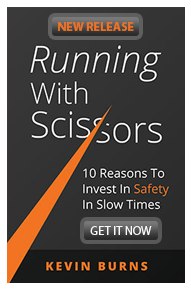How To Get A Return On Safety (Excerpt from Running With Scissors)
Safety is not argued as an economics case. It is presented as an enforcement initiative.
(Excerpt taken from Kevin’s new e-book, Running With Scissors - 10 Reasons To Invest in Safety In Slow Times.)
 Safety suffers from an identity crisis. Senior management view safety as legislation and a legal requirement. They see it as a cost of doing business or that which gets in the way when there is a production crunch on. Safety is an add-on - the enforcement part of a compliance program. Safety has become a set of rules that constrict the company’s operations. It is an expense just waiting for an excuse to be cut.
Safety suffers from an identity crisis. Senior management view safety as legislation and a legal requirement. They see it as a cost of doing business or that which gets in the way when there is a production crunch on. Safety is an add-on - the enforcement part of a compliance program. Safety has become a set of rules that constrict the company’s operations. It is an expense just waiting for an excuse to be cut.
The Cutting Begins
The tug-of-war between production (revenue) and safety (expense) causes senior managers to find ways to cut expenses. This is especially true when business slows down. Safety management, though, is made up of two parts: safety and management. One needs exceptional management skills to be successful at safety.
The safety managers' primary responsibility is compliance; with legislation and regulations. They are also responsible for reducing costs and worker insurance premiums. Cut workplace injuries and incidents and that reduces costs.
Safety is not considered as a way to generate revenue. That's why safety is one of the first programs to feel the swift slice of the scissors in a downturn. In slow times, to stay lean, companies will cut - slicing away at the perceived fat. Safety, in the eyes of executives, is fat.
Safety is Not Argued As Economics
Safety is not argued as an economics case. It is presented as an enforcement initiative. But there are no perceived ways to generate revenue to the company through safety. That’s why safety is viewed as an expenditure.
So, to enforce compliance, employees are exposed to gruesome injury photos and graphic videos. Employees, at times, are forced to listen to a worker’s story of how they lost a limb or how they became disfigured. It’s the shock-and-awe program of getting mere compliance from employees. “Fail to follow protocols,” you hear them say, “and you too could lose a body part.”
What-if’s and maybe’s don’t sell safety well. The reason is because so few workers ever suffer a workplace injury. Most of your people stay safe. Most of your people will not be able to relate to something that only happens to a small percentage of workers. It’s how workers develop the mindset of, “That will never happen to me.”
Safety Ensures Production
Safety is not just an injury-prevention program. Safety is a production stoppage-reduction program. It is also a philosophy to ensure that companies care about their most important asset, their people. Safety is designed to ensure that people stay safe and production is not interrupted. It's the classic win-win. It keeps cash-flow going: both for the employee and for the company.
Without production, there is no need for safety. Without safety, there is no steady production. Each depends on the other. But safety managers want to talk only about safety. Operations managers want to talk only about production. But they are not separate from each other.
Safety is an investment program. Every company will spend money on safety - either voluntarily or against their will. But they will spend. The question is: will they get a return on their investment? Or, will they as many do already, take a loss?
Treat Safety Like Financial Plan
 Like a financial plan that gets you to retirement, safety is that vehicle that gets employees to their golden years. Without safety, what is the point of investing in a retirement plan? Without cash-flow, there is no way to contribute to retirement. You need both.
Like a financial plan that gets you to retirement, safety is that vehicle that gets employees to their golden years. Without safety, what is the point of investing in a retirement plan? Without cash-flow, there is no way to contribute to retirement. You need both.
Without safety, incidents will bankrupt a company. Staff will turnover, attrition will be high and costs will be astronomical. Reputations will be soiled. Employer-of-choice status will be lost. Scrutiny from government inspectors will slow down production to a painful pace. Safe production keeps the company liquid. It ensures cash-flow – for both employees and the company.
No company can ever be successful without looking out for the safety and well-being of their employees. Safety is a corporate value - a way of respecting and caring for the people that keep the company running.
No company can ever sustain long-term success by Running With Scissors. Download the free e-book to discover 10 Reasons To Invest in Safety In Slow Times.
Kevin Burns is a management consultant, safety speaker and author of "The Perfect Safety Meeting" and the new "Running With Scissors - 10 Reasons To Invest In Safety In Slow Times." He is an expert in how to get through to people - how to talk with them so they hear and understand. Kevin's presentation "Trust The Process - Instill A Safety Attitude To Build An Engaged Culture Of Safety" will help your organization reach the following goals: better engagement and buy-in to safety, increased teamwork, better communication, lower turnover resulting in increased profits from production. Click here for more information and to discuss your needs with Kevin.


